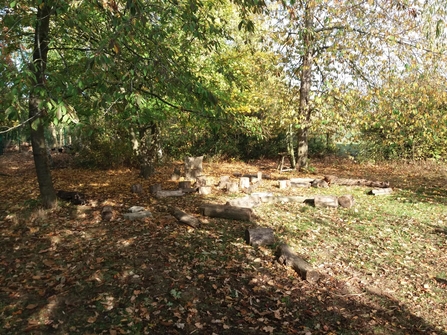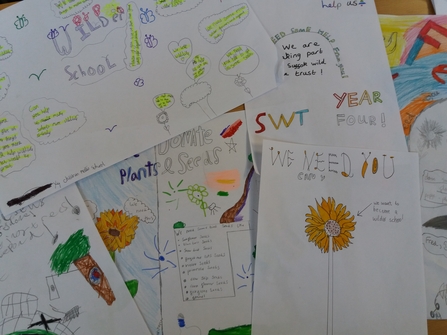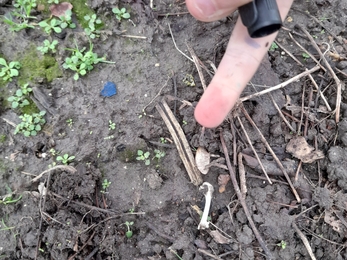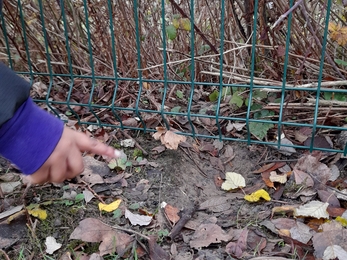Timeline of our relationship with Mellis Primary

13th October 2022
Wild Learning Officer Deborah Key spent the day at Mellis Primary, starting by finding out how connected the Year 4 class feel to nature. The class drew some brilliant maps of the school grounds, including features from memory. Following a whole school assembly, where the Wilder Schools project was introduced to the rest of the school, the Year 4 class then went outside to measure and count the different habitats and features. We looked for hedgerows, trees, woodland areas, playing fields, flower beds and ponds.
There is already a quiet area in the school grounds, with a pond, woodland area and fruit trees. This is the area the school would like us to focus on, to help improve it for wildlife and make it a space regularly used for outdoor learning.
In the afternoon, school staff and a parent helped make a start by improving the pond and finding places for three new fruit trees. Some of the pond vegetation was removed (which was left on the side for small animals to crawl back into the water) and overhanging branches, shading the pond, were trimmed.
30 November 2022
On our second visit, we headed outside with Year 4 to take a closer look at the quiet area and the features in it. The children made maps of the area, went minibeast hunting and looked at priority species and what they need to survive. Back in the classroom this helped them to think about some actions they might need to take to improve the area for wildlife. Working in groups they looked through books and leaflets to research ideas and start to come up with some actions and think about how these might be achieved.
During the day we met the Eco club and found out what they were doing to help wildlife and asked them for their help with the Wilder Schools project.
After lunch there was a visit from members of Street Forge workshops, who donated a number of nest boxes, a hedgehog box, bee boxes and insect homes. With the help of Year 4 they put up the nest boxes and we found places for all the other homes. We also helped to plant some saplings in the woodland.
12 January 2023
Following on from our last visit, the Year 4 class continued to research ideas for improving the school grounds for wildlife. They used books, leaflets and priority species information provided, and made spider diagrams to record their ideas. We started to put together an action plan by discussing their suggestions and thinking about achievable tasks, the resources needed, where these would come from and any fundraising that might be required.
Features were added to a map of the school grounds to show what is already there that is beneficial to wildlife and what they would like to add. They also started to make plans for a school assembly to let everyone know about the project, what they were doing and how everyone can help.
After lunch we headed out into the school grounds to look for signs of animals using 'Animal detective' sheets. They found rabbit droppings, nests, holes in the ground and even a small bone. Then it was time for a tree study, measuring some of the trees to try to find out how old they are and using clinometers to work out their height.
7 March 2023
On this visit, the Year 4 class focused on the resources needed for the actions they hope to take, including building a big bug hotel, planting a wildflower meadow and feeding the birds. They have already written letters to the Parents’ Association asking for funds for wildlife cameras and were excited to report that they had been successful in their request.
Working in groups they either; planned an assembly to let the whole school know about the Wilder Schools project and what they are doing; designed posters to put up around school and village to let people know about the project and ask for donations; or wrote persuasive letters asking for donations of plants and seeds.
In the afternoon, we headed outside to the quiet area (now called the wildlife area) and the children took part in some activities to find out all about hedgehogs.
Finally, back in class, they started to come up with a plan for a fundraising event.
Before our next visit, they are going to present their assembly to the rest of the school, ask other classes for their ideas and record them in a book and make a video about the project to send to parents.

Deborah Key
27 April 2023
Today, we discussed plans for the fundraising day. It was decided that this would involve giving all the children in the school the opportunity to spend some time in the wildlife area and help to improve it, in return for a small donation from their parents. The Year 4 children decided on the activities and they worked in groups to plan each activity. They had to make a timetable, think about how many staff were needed for each activity, what equipment was needed and health and safety.
In the afternoon, they chose a position in the wildlife area to build a bug hotel and made a start with the materials that had already been collected or donated. An area was also chosen to sow wildlife seeds and they started to prepare the ground. They took it in turns to do these activities as well as make two nest boxes from kits, that they could use to raise some funds. They also looked for flowers, to compare the number of plants found in the wildlife area to the number found on the playing field.
19 May 2023
Today was the fundraising day. The Year 4 class had prepared a timetable and each child in the class had a role to play in organising the day. All of the children in the school from Reception to Year 6 had the opportunity to spend time in the wildlife area and help with actions to improve it. Parents were encouraged to donate to a 'JustGiving' page to help support the ongoing work to improve the area for wildlife.
Each year group came outside during the day and, working in small groups, rotated around the activities.
A fantastic bug hotel was built using wooden palettes, bricks, broken tiles and plant pots and then filled with whatever could be found, such as bark, twigs and wood. There were even enough palettes and bricks to start a second hotel next door.
Each year group had an area to sow some wildflower seeds. The areas were marked with hoops and they had to finish clearing the ground before sowing the seeds.
Plastic bottles were used to make bird feeders with perches made from sticks and reused wooden forks.
As well as making the area better for wildlife, all the children had a turn at pond dipping to see what could be found. They were all very excited when a smooth newt was caught and there were also water lice, water boatmen, freshwater shrimps and ramshorn snails.
After all the year groups had been out, the Year 4 children tidied the area and then made signs to put out ready to give parents an after-school tour, highlighting the bird feeders, bug hotel, nest boxes and wildflower area.
8 June 2023
Today the Year 4 class visited Redgrave and Lopham Fen. They explored some of the habitats of the fen, looking for invertebrates in the wood and fen meadow and comparing the type of creatures found. They also pond dipped in a fen pool and went orienteering, having learnt how to use a map and compass to find their way.
12 June 2023
Today the Year 4 class did an invertebrate hunt in the school's wildlife area to compare the creatures they found to those they found during their visit to Redgrave and Lopham Fen. There were lots of slugs under logs and some slug eggs, woodlice, spiders (including a woodlouse spider), flies, beetles (including a thick legged flower beetle) and a lot of mosquitoes.
Back in the classroom, they drew maps of the school grounds, to include all the features they could think of from memory. Then it was time to finish this year’s activities with a survey, out on the playground, to find out how connected to nature they now are.





